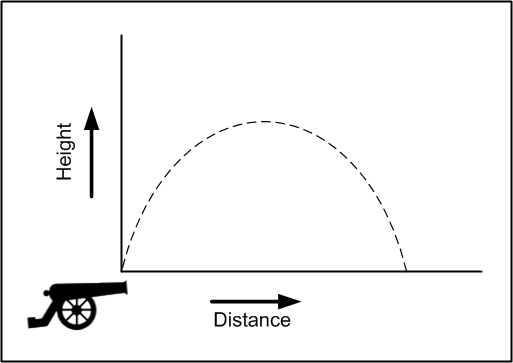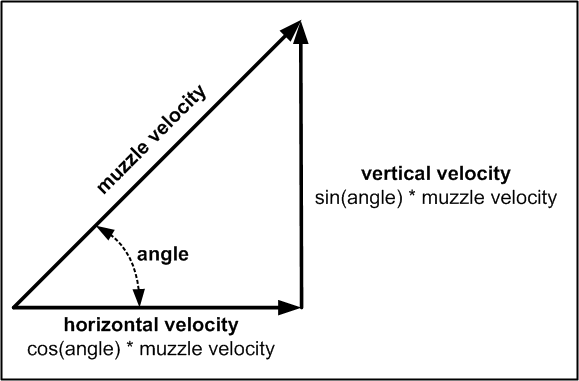Introduction
If you shoot a cannon, how far will the cannon ball go before it hits the ground? How high will it go?

Design
- All input and output data is in feet/seconds/degrees
- The acceleration of gravity is 32 feet/sec/sec (9.8 meters/sec/sec)
- There is no air resistance to slow the cannonball
- The earth is flat (no curvature)
- Ignore the rotation of the earth
- Ask the user for:
- The cannon's angle above the horizon
Do not allow angles less that 20° or greater than 90° - The muzzle velocity of the cannon
Do not allow velocities (less that 10 feet/sec or greater than 2000 feet/sec?)
- The cannon's angle above the horizon
- Display
- Cannonball flight time (seconds)
- Horizontal distance traveled (feet)
- Maximum vertical distance (feet)
Calculation

Input
Horizontal and Vertical VelocityVm // muzzle velocity (feet/sec) A // cannon elevation angle (degrees)
Time (seconds) to the top of the arc (zero vertical velocity)Vv = sin(A) * Vm // vertical velocity (feet/sec) Vh = cos(A) * Vm // horizontal velocity (feet/sec) Note: Depending on which programming language you use, you may need to convert angles in degrees to radians. For example, the Python sin and cos functions require radians. Radians = Degrees x Pi / 180 (Pi is approximately 3.14159) (1 radian is approximately 57.296 degrees) (1 degree is approximately 0.0174532925 radians)
Total time (seconds) of flight - up and then downTtop = Vv / 32.0 Note: 32.0 = acceleration of gravity (feet/sec/sec)
Horizontal distance (feet)Ttotal = 2 * Ttop
Vertical distance (feet) to top of arc (zero vertical velocity)Dh = Ttotal * Vh
Dv = (Vv)2 / (2 * 32.0) Note: 32.0 = acceleration of gravity (feet/sec/sec)
Note: Go
here  for more information on the calculation
for more information on the calculation
Try This
Plot the cannonball's trajectory.